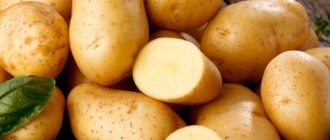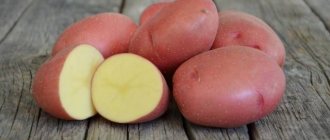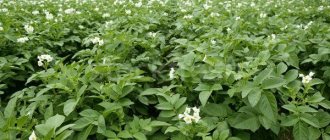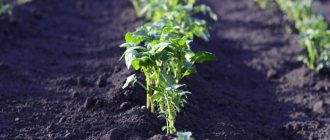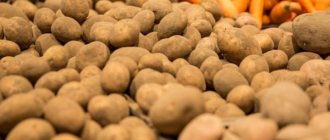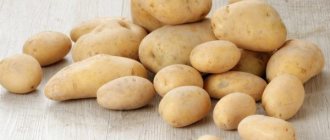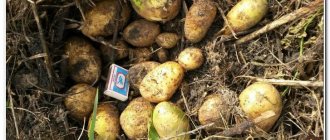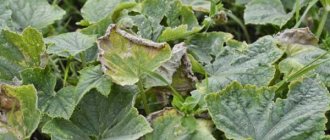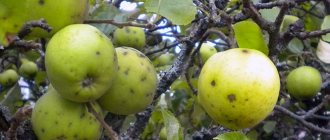National averages
Provided that all the required technologies are followed, growing this crop can become a truly profitable business. The average potato yield per 1 hectare in Russia is 150 centners. However, this figure may not be the same in different regions of the country. Of course, the weather conditions of a particular area have a huge impact on the yield of this plant. Also, the success of growing this crop directly depends on the properties and composition of the soil in that particular area.
In principle, potatoes can be grown in almost any region of Russia, with the exception of the Arctic. However, in some regions there are the most favorable conditions for cultivating this crop.
The majority of potatoes are grown industrially in our country in the Bryansk region. Today it is the leader in the supply of root crops of this crop to the domestic market. Potato yields in the Bryansk region are very high. For example, in 2016 it was approximately 229 c/ha.
The Tula region is in second place in Russia in terms of area allocated for potatoes. This culture is also quite widespread here. The average potato yield per 1 hectare in the Tula region in 2021 was about 250 c/ha.
Also, a lot of potatoes are grown in our country in the Nizhny Novgorod, Sverdlovsk, Moscow, and Astrakhan regions. Udmurtia, Chuvashia, and Tatarstan are among the ten largest suppliers of root crops of this crop. Large areas of potato cultivation are also occupied in the Tyumen region. In addition, this crop is grown in quite large quantities in the Leningrad region. The potato yield per 1 hectare in this region in 2021 was about 200 centners.
Thus, this culture feels best in the European part of Russia and the Urals. But of course, they also grow it in Siberia. Potato yield per 1 hectare in this region is 200-300 c/ha, depending on the specific region and variety.
Potato yield per 1 sq.m.
The so-called “exit” from one hundred square meters depends on the circumstances, let’s discuss them:
- if the soil at your summer cottage is of poor quality, then do not expect a big harvest;
- the culture does not tolerate temperature fluctuations; cold, drought and heat can destroy the harvest.
To get a lot of potatoes by planting them in a small area, you will have to pay special attention to the planting material. Gardeners recommend planting only potatoes that are similar in size to a chicken egg.
When it comes to the yield of a crop, it varies; in our country, it is unlikely that one hundred square meters will yield more than 100 kilograms.
Average indicators in summer cottages
Of course, large agricultural companies have all the capabilities to grow good potato crops - modern technology, good herbicides and fertilizers. Therefore, such enterprises can collect 150-200 ha/c of root crops and more.
However, in summer cottages, potato yields are even larger. Indeed, in this case, the gardener works mainly for himself and his family. And therefore, he gives all his strength to the task. Some summer residents manage to collect 650 c/ha from their plots. On average, the potato yield at dachas in Russia is 200-250 kg per hundred square meters. This is, of course, quite a lot.
How to increase potato yield
In order to increase the potato yield, it is necessary to water it, hill it and weed it on time. But there are still some tricks that allow you to exceed the possible results from cultivating this crop.
Disinfection of planting material
Disinfection of seed material can improve its resistance to diseases and adverse factors. This procedure can be performed in two ways. One involves soaking the tubers for 2-3 hours in a special solution. The second involves spraying them with a spray bottle.
Recipes for disinfection solution:
- Garlic. 1 kg of crushed garlic is diluted in 10 liters of water.
- Nutritious. Mix 5 g of copper sulfate, 15 g of boric acid and 0.5 g of potassium permanganate. Pour in 10 liters of water.
- Superphosphate. 60 g of superphosphate, 40 g of urea, 5 g of copper sulfate, 1 g of potassium permanganate and 10 g of boric acid are dissolved in 10 liters of water.
- For spraying. Dilute 30 g of calcium sulfate, 40 g of urea, 15 g of boric acid, 1 g of copper sulfate and 0.5 g of potassium permanganate in water. Approximately 100 kg of potatoes will require 1 liter of solution.
On a note!
It is better to spray potatoes before the tubers have sprouted. If the roots have already appeared, then it is better to wait until the potatoes turn a little green and then apply an aerosol treatment. In this case, it is better to reduce the concentration of the solution by half.
Bathing in a nutrient solution
This method can increase productivity by 10-15%. For sprouted tubers, bathing is best done two days before planting in the soil. The nutrient solution will allow the root crop to form sprouts faster and speed up the germination of the tops.
Water the tubers with water with the addition of 40 g of superphosphate, 40 g of nitrogen fertilizers and 40 g of potassium salt. All ingredients are diluted in 10 liters of water. This is exactly the amount of solution needed for 50 kg of seed potatoes.
On a note!
It is better to bathe unsprouted tubers a day before planting in the soil.
Stimulating incision
This method will require an impressive amount of time. Therefore, it is advisable to use it when growing potatoes on a personal plot, where planting volumes are small. The use of cuts can increase potato yield by 12-13%. It is necessary to make cuts on the tubers in advance, even before germination. It is best to carry out this procedure 1.5-2 months before planting.
Transverse cut
This trick allows you to activate potato eyes not only in the upper part, but throughout the entire surface of the tuber. If you plant whole potatoes, only the top ones will sprout.
A cut is made across the potato. It is deep and bisects the tuber almost completely except for a small bridge about 1 cm wide.
This manipulation allows the nutrients in the seed to be distributed evenly. The result is a strong bush with a large number of stems from each tuber. For clarity, you can try cutting some of the seed potatoes in the country, and leaving some untouched, and then compare the results. Official experiments have shown up to a 20% increase in yield.
Circular cut
Such manipulation also stimulates the germination of eyes, which remain “dormant” under normal conditions. The procedure is carried out with a knife (it is more convenient to attach a limiter to it). An incision 1 cm deep is made across the entire surface of the tuber. To prevent the spread of diseases, the knife must be periodically disinfected in a light solution of potassium permanganate, and try to choose healthy tubers.
The incision can be made transversely or longitudinally. In the first case, the germination of the lower and lateral ocelli is stimulated. And in the second, they remain unused, but the upper ones grow faster.
On a note!
To obtain a high yield, it is necessary to keep the treated tubers warm for about a month. In this case, the ambient temperature should not drop below 14 ºС.
Proper watering
Potatoes are quite easy to care for and require almost no watering. It is enough to give it water 1-3 times a year. The right time is when the first shoots appear and buds set. If the weather is dry and there is almost no rain, then additional watering will certainly increase the potato yield.
On a note!
If the soil dries out by 7 cm or more, it is recommended to water the potatoes in order to preserve the harvest.
Top dressing
In order to get a larger potato harvest, it needs to be fed. In practice, people most often use manure, which is spread over the surface of the field before planting.
If there is little manure and you have to save it, you can place it directly in the furrows before planting.
May be interesting Potatoes Lugovskoy: description and characteristics, reviews Potatoes Hostess: descriptions and characteristics, reviews Planting potatoes using Dutch technology: features, diagram, harvesting
A compost heap can be an excellent source of fertilizer. It is usually organized at a summer cottage. Throughout the year, grass and food waste are thrown into the compost. Special humus worms can speed up the process of fertilizer formation.
In order to increase the potato yield in your home garden, you can use a three-component fertilizer. It includes the following steps:
- 15 glasses of humus and 10 tsp. urea is mixed. This amount of fertilizer is enough for a 10 m furrow. This type of feeding will be most effective during the formation of stems. It will strengthen them and accelerate growth.
- 30 tbsp. l. ash and 10 tsp. calcium sulfate. Also enough for 10 meters of landing. Stimulates the formation of inflorescences. It is most effective to apply at the very beginning of flowering.
- To stimulate the formation of tubers, two recipes can be used. The first involves mixing 2 tbsp. l. superphosphate, 2 tbsp. l. potassium sulfate and 1 tbsp. l. nitrophoska per 10 liters of water. Each bush will require 0.5 liters of solution. The second is simpler, but also effective. Water the potatoes with a solution of 2 tbsp. l. superphosphate per 1 meter of furrow.
On a note!
You should avoid feeding potatoes with organic matter during flowering. This can cause disease outbreaks and increases grass growth.
Hilling
The traditional method of growing potatoes involves two hillings. It is produced using a plow or a special device by hand.
The plant is earthed for the first time after the first shoots appear. This should be done the second time when the stems stretch 20-25 cm. This technique will speed up the formation and growth of tubers, and will also allow you to get rid of weeds for a while.
Pest and disease control
To combat the mole cricket and the Colorado potato beetle, both traditional methods and various purchased insecticides are used. In the spring, when planting, traps are installed along the edge of the site and between the rows.
What factors can influence yield?
Most summer residents believe that potatoes are an annual crop. However, this is not the case. Potatoes are a nightshade perennial. Its tubers are not roots at all, but thickenings of the underground part of the stem. The eyes distributed along them are growth points. It is from them that new stems grow, on the underground part of which tubers form again.
Actually, potato yield is influenced, of course, by many factors. However, the decisive ones are:
- soil structure and composition;
- illumination of the area;
- timeliness of watering;
- correct choice of variety.
This crop loves airy soils. That is why potatoes must be loosened and hilled when growing. It is also believed that sandy loam, loam, chernozem and peat soils are best suited for this crop. The optimal pH for this crop is 5.1-6.0.
How to care
Although potatoes are easy to care for, this does not mean that after planting you can forget about them.
How to water correctly
To have a good harvest, potatoes need to be watered twice in dry summers:
- In the budding phase - the beginning of flowering.
- During the period of intensive harvest formation (early to mid-August).
Water so that the moisture penetrates to a depth of 15-20 cm - this is where the ash of the roots passes through.
Per 1 hectare, water consumption is 2.5-3 m³.
If it is impossible to water the plants for any reason, water the weeds and loosen the soil to a depth of 6 cm. The loose layer of soil retards the evaporation of moisture. There is no need to hill up the potatoes.
The number of tubers depends on rains or watering in June-July, and their weight in July-August.
What to feed
The size of the potato harvest largely depends on the content of a sufficient amount of macro- and microelements in the soil.
For example, there is a proven granular fertilizer “Kemira Potato-5”. It is applied in the spring, when preparing the soil or during planting. You can feed potato plants during the growing season by scattering them on the surface of the soil between the rows. The average application rate is 6-8 kg per hundred square meters.
Rotted manure is used as an organic fertilizer. compost, humus, peat.
The remaining care methods after planting (harrowing, loosening, hilling, weeding rows) are usual. You can get acquainted with them in this publication RBlogs.ru.
Features of cultivation
To get large yields of potatoes, they need to be planted only in sunny places. Under the canopy of trees, for example, this plant will not develop well.
During the active growing season, potatoes require quite a lot of water. To obtain a good harvest, you need to spend approximately 35-45 m3 per one hundred square meters. The timing of watering is also important. Potatoes are especially in dire need of moisture during tuber formation. After flowering, watering of this crop is usually reduced.
Of course, in order to get a good potato harvest, various types of fertilizers should be used when growing them. This crop responds very well, for example, to ordinary rotted cow manure. In any case, during the growing season in Russian conditions, this plant is in dire need of nitrogen, potassium and phosphorus.
Calculating the amount of harvest
Potato yield depends on many factors, including: variety, quality characteristics and size of planting material; type of soil; climatic conditions; cultivation technology.
We calculate the amount of harvest per hundred square meters, hectare. Cultivation using the traditional method, planting in rows.
| Row width | Step between planting tubers | Number of furrows | Number of tubers/bushes in a row | Number of mother tubers | Can be assembled | ||
| 1 weave (10 x 10 m) | |||||||
| 400 mm | 14 | 25 | 350/ weight with reserve 29 kg | 525 – 700 kg | |||
| 1 hectare | Output per hectare | ||||||
| 400 mm | 142 | 250 | 35,500/2.9 tons | 4.350 t - 5.8 t | |||
The use of innovative techniques will double the yield.
Varieties
Summer residents and agricultural enterprises in Russia grow different types of potatoes - with white, red, yellow and even purple tubers. But in any case, for cultivation it is worth choosing only high-yielding varieties that have earned good reviews. For example, growing varieties Gala, Red Scarlet, Nayada, and Russian Beauty in the Russian climate gives very good results. The yield of Gala potatoes per 1 hectare is, for example, about 250-260 centners. This variety is quite popular among summer residents. Therefore, getting Gala potato planting material will not be difficult.
Potato yield per variety varies quite a lot per hectare. It is believed that the largest number of tubers can be obtained from late and mid-season hybrids of this crop. For example, the yield of potatoes of the Lugovskoy variety can reach 50 tons per hectare. Early ripening potatoes usually produce fewer tubers. But such varieties are more resistant to various kinds of diseases.
Increase in quantity
What is considered the maximum potato yield per hectare is not difficult to figure out. You can increase the amount of harvest by fulfilling certain conditions:
It is necessary to select potato varieties for planting that are grown and bear fruit well in the given region. The yield of different potato varieties differs quite significantly. Late and mid-season hybrids are considered higher yielding. Early varieties usually produce fewer tubers. But they are more resistant to various kinds of diseases.
- When cultivating a vegetable crop in the same area for many years, the yield drops significantly. It is necessary to change the place for planting potatoes every four years.
- Soils with high moisture and air permeability, mainly sandy and sandy loam, are suitable for potatoes. Saline or clayey soil is absolutely unsuitable for cultivation.
- Before planting, the soil is thoroughly loosened so that the roots receive enough water and oxygen.
- Forage and legume plants are used as green manure.
- Before plowing, organic fertilizers and mineral fertilizers are added to the soil.
- Early ripening potato varieties need magnesium-containing complexes.
Ways to increase productivity
By following potato cultivation technology, you can harvest a very large number of tubers at the end of the season. However, there are also special technologies, following which you can obtain maximum yields of this crop. In order to grow as many high-quality tubers as possible in your country house or on the field of an agricultural enterprise, you should:
- observe crop rotation;
- use the correct planting pattern;
- take only processed, well-disinfected tubers for planting;
- arrange the plantings so that the rows are directed from north to south.
If all these conditions are met, potato yields can be increased to 15-20%.
How many potato seeds are needed per 1 hectare?
The main goal of growing seed potatoes is maximum yield with the smallest tuber size. This is important because small seed potatoes are more expensive than large ones. A high yield with a small number of tubers is achieved only due to a large number of these tubers. This is achieved due to greater planting density. For example, in the Netherlands the optimal density is 25 - 45 base stems per square meter.
The optimal density of bushes is selected depending on the variety, soil type, length of the growing season (class), the price of seed potatoes in general and a certain size of seed material. Ask your trading partner (or whoever you buy your seeds from) to select the best density for the selected variety, taking into account all local conditions. If the bush does not completely cover the leaves with soil, then during hot periods there is a risk of secondary growth. As a result of this germination, secondary tubers with a very low dry matter content are formed, and the primary tubers are deformed.
Having determined how many seed crops need to be planted per hectare to achieve the required plantation density, the distance between bushes in a row is easily pink. Let's say you want to have 35 thousand plants per hectare. This means that the area of one plant will be 10,000 m2 / 35,000 = 0.286 m2. If the distance between rows is 75 cm, the distance between bushings in a row will be 2.860 cm2 / 75 cm - 38 cm.
Tricky ways
At the dacha, to increase the yield of this crop, you can also:
- cut the tubers before planting around the circumference to a depth of 1 cm to stimulate the development of sprouts;
- 15 days after flowering, break the stems at a height of 10-15 cm from the soil level.
In the latter case, the nutrients, rushing to the top of the stem, at the site of the break, will turn down and go to the tubers. As a result, potato yields will increase significantly. But of course, when using this technology, it is not worth breaking the plant stems completely. After this procedure, they should simply lie on the ground without losing their integrity.
Growing technology
To collect not only the first, but also the second harvest of the crop, you will have to follow the recommendations:
- Regular watering procedures will help to grow potatoes correctly. The crop is actively watered during the growing season, when tubers are formed, then the number of procedures is reduced.
- Vegetables are planted in a sunny place; they grow poorly in the shade of trees. Gardeners prefer flat surfaces that are well lit by the sun.
- To harvest two crops in a season, you will have to feed the plant; humus and cow manure are used as fertilizers. Potatoes are fed when planting, the procedures are repeated after 10 days, then fertilizers are used when the crop begins to bloom.
- You will have to treat the planting and eliminate pests; for this purpose, various solutions (insecticides) are used.
Advice: potatoes are cultivated on an industrial scale using modern technologies. It is not advisable to use manual labor when you have to cultivate a hectare of planting.
If a summer resident lives in Siberia, then he will only be able to harvest several potato crops if he cultivates them in greenhouse conditions. Preference is given to early and mid-ripening varieties.
When the climatic conditions in the region can hardly be called favorable, you will have to:
- Choose a potato variety based on the climate.
- Plant crops in a timely manner, having previously chosen a location.
- Fertilize the soil, monitor the quality indicators of the soil.
See also
Description of the Slavyanka potato variety, planting technology and care
Read
It is advisable to use green manure, they will help the soil to “rest”. The land is sown with green manure after harvesting. When the crop grows, it is mowed and then the soil is dug up. The procedure can be repeated in the spring.
Features of crop rotation
Ideal predecessors for potatoes are legumes and perennial herbs. This crop can also be planted after grains. In the fields of agricultural enterprises, the following potato crop rotation scheme is usually used:
- first year - grains;
- the second is perennial herbs;
- third - legumes;
- fourth - potatoes.
On small dacha plots, it will, of course, be difficult to implement such a scheme. Most gardeners plant potatoes in the same place year after year. However, even at the dacha, the land should be given a rest. At least a small part of the plot should be planted with green manure every year. You can also periodically change the places intended for growing vegetables (except nightshades) and potatoes.
Disinfection of tubers
This procedure is carried out in order to increase potato yields and should be carried out without fail. Tubers can be disinfected using different means. For example, very often the processing of potato planting material is carried out using:
- garlic solution prepared in the proportion of 1 kg of chopped cloves per 10 liters of water;
- a solution of copper sulfate (5 g), boric acid (15 g) and potassium permanganate (0.5 g) in 10 liters of water.
It is also advisable to use a nutrient solution before planting to speed up the germination of tubers. It is prepared from the following ingredients:
- superphosphate - 40 grams;
- nitrogen fertilizers - 40 g;
- potassium salt - 40 g;
- water - 10 l.
This amount of solution is enough to spray 50 kg of tubers.
Factors influencing the amount of potato harvest
In order to create comfortable conditions for potatoes, it is necessary to take into account a number of factors, including soil characteristics, and observe crop rotation. Plant green manure, plants that additionally enrich the soil with nitrogen.
Crop rotation
The harvest will be high if you follow crop rotation.
Green manures, good predecessors of potatoes, are:
- winter crops: barley, rye, wheat;
- peas and other legumes;
- mustard;
- lupine.
A good potato harvest depends on:
- From the correct choice of the variety of mother tuber.
- The variety must correspond to the climatic conditions of the region.
- On the quality of tubers intended for planting. It is recommended to choose potatoes 5 cm or larger in size, with good sprouts.
- It is important to prepare tubers for planting: germination, disinfection.
- From proper preparation and arrangement of beds. The optimal location for the potato furrow is from north to south.
- Growing techniques.
- It is necessary to take into account the qualitative characteristics of soils.
- Fertilizing with organic and mineral fertilizers.
- Productivity depends on watering. Select the optimal mode for a specific climate zone.
- From comprehensive care.
- On the effectiveness of pest and disease control.
Before planting, potatoes are disinfected.
Healthy planting material
An important point is preparing the tubers for planting. Within two weeks, the potatoes are sorted and the sprouted sprouts are removed.
Expert opinion
Stanislav Pavlovich
Gardener with 17 years of experience and our expert
Ask a Question
Important! Choose healthy tubers (from 5 cm). Potatoes are disinfected to prevent diseases and protect against pests.
The following compositions are used:
- garlic twisted in a meat grinder (1 kg per 10 l), soaked (for 2-3 hours) or sprayed.
- copper sulfate and boric acid in the ratio: 5 g of vitriol, 15 g of acid per 10 l;
- superphosphate (60g), urea (40g); copper sulfate (5g), potassium permanganate (1 g), boric acid (10 g). Dissolve in 10 liters of water.
- Potassium sulfate (30 g), urea (40 g), boric acid (15 g), copper sulfate (1 g), manganese (0.5 g) are dissolved in 10 liters of water.
See also Causes of blackening of leaves and tops of potatoes
Soak for several hours or spray the mother tubers.
They determine the technology for growing potatoes in order to properly prepare the soil and beds.
Selection of productive varieties
All potato varieties are divided into early varieties (reach maturity in up to 60 days). Potatoes are meant to be eaten and are not stored for long.
Medium (vegetative period up to 100 days) and late (up to 140 days) varieties are suitable for winter storage.
Varieties from 350 to 500 or more centners per hectare are considered productive. These varieties include: Idaho, Udacha, Bellarosa, Ryabinushka, Temp, Radonezhsky.
Note. High-yielding varieties of foreign selection include: Impola, Condor, Latona, Red Scarlet, Ukama. They have large tubers and are resistant to diseases, in particular potato nematode.
Soil composition
To grow any agricultural crop, you need to select the most suitable soil composition.
Expert opinion
Stanislav Pavlovich
Gardener with 17 years of experience and our expert
Ask a Question
Important! A loose, well-fertilized soil structure is the best soil for potato development. Provides free access of oxygen to the root system and promotes tuber growth.
Potatoes grow well on sandy, loamy peat lands and black soils. Slightly acidic soils with a pH of 5.5 are suitable for cultivation.
Proper planting and care
An important point is preparing the tubers for planting. Within two weeks, the potatoes are sorted and the sprouted sprouts are removed.
They determine the technology for growing potatoes in order to properly prepare the soil and beds.
For the growth of potato tubers, space is needed, so the distance between the bushes is at least 25-30 cm, and the row spacing is from 65-75 cm.
Potatoes develop at temperatures from 16 to 20⁰С. In hot weather, there is a high probability of buds wilting, and accordingly, the growth of tubers is inhibited.
You should not plant potatoes in early spring when there is a threat of frost. The plant can die, even from a slight frost, if it is not covered with film.
Moderate humidity is the optimal regime for potato development. In temperate climates, three waterings are sufficient: during planting, before and after flowering. In dry areas, additional watering is required.
Mulching prevents the development of weeds, maintains optimal moisture conditions, and fertilizes the soil.
Special techniques
There are methods by which the yield rises to 400-500 centners per hectare.
Mittlider method
Potatoes are grown in narrow beds, up to 9 m long and 0.45 m wide, with row spacing up to 1 meter. The American agronomist believes that in such beds the bush develops better and large tubers are formed. The technology is suitable for smooth terrain or with minor irregularities. In the second case, it is rational to install stationary beds with sides up to 35-40 cm high.
Planting using the Mittlider method:
- The beds are arranged from north to south. Using pegs with a rope, markings are made.
- Prepare the ground. The markings limit the edges of the bed. Select the middle of the bed. Make a shallow groove for applying mineral fertilizers.
- They dig up the soil in the garden bed to mix fertilizers with the soil.
- Use a rake to level the soil in the garden bed. Sides up to 10 cm high are formed along the edges to retain moisture.
- Mark the holes. Potatoes are planted sprouts up, in 2 rows with an interval of 30 cm between holes, according to a checkerboard pattern. Sprinkle with earth and carefully level with a rake.
They retreat 1 m from the bed and form the next one.
It is recommended to regularly moisten the soil in the beds; the space between the rows is weeded and trampled down.
Note! According to the Mittlider method, mineral fertilizers are mainly used. The composition of fertilizers is selected depending on the type of soil.
Gülich technology
Interesting technique. Large tubers are used as seed material.
Sequence of planting potatoes:
- The area is marked into squares 1 m x 1 m. I mark the middle.
- A recess with sides is made in the center. Humus and overripe manure mixed with soil are poured into it and a small mound is formed.
- Large potatoes are planted in it, sprouts down.
- When young shoots appear, they are sprinkled with earth in the middle. The stems of the bush grow to the side, like rays. Sprinkled with soil, they send out additional axillary roots.
- The operation is repeated several times as the plant grows. As a result, new roots grow from the leaf axils and tubers are formed.
- During the growing season, potatoes are fed, watered, and the soil is loosened. A powerful bush of several tiers is formed.
See also Potato pests: description and control of them
The yield from one bush is 12-15 kg.
Pinto technology
Mark the bed into equal squares. At the intersection points, the mother tuber is pressed into the ground. They do not cover it with soil; they keep it for 2-3 weeks. When shoots appear, sprinkle with earth, without hilling. The point of the technique is that slightly dried potatoes develop a more powerful root system. Productivity increases.
Dutch method
Methods for growing potatoes in ridges. Dutch potato varieties are suitable as mother tubers.
Planting potatoes using the Dutch method:
- The land for the beds is prepared in the fall. Dig to the depth of a shovel. Organic fertilizers, superphosphate, and potassium sulfate are applied.
- In the spring, do 2 fertilizing with urea. The soil is loosened to a depth of 15 cm with a cultivator.
- The uterine tubers are germinated and pickled for a month, in the dark, at temperatures up to + 18⁰ C.
- Mark the area: furrow width 35 cm, step between bushes 35 cm, row spacing 70 cm.
- Add organic fertilizer and a little eggshell to each hole.
- Potatoes are planted and soil is covered in a layer of up to 6 cm.
- Weed when weeds appear.
- After 2 weeks, add soil and raise the ridge to 12 cm.
- As the bush grows, increase the height of the furrow to 30 cm, raking up soil from between the rows.
- 2 weeks before full maturity, the tops are cut off.
- Potatoes are kept in the ground for 2 weeks. Then they dig it up.
Note. Potatoes in ridges are more convenient to process; the yield rises to 400 kg per 1 ha.
Growing potatoes in straw
This method is suitable for difficult soils, including rocky ones. The technique is simple: the potatoes are laid out in shallow holes and lightly sprinkled with soil. Cover the top with straw, a layer of 30 cm. Hay, garden mulch, sawdust, and mown grass are used as covering material. Moisture is retained inside the straw pile, and the potatoes receive fertilizer from rotting plants.
Important! The advantage of the technique is not only in increasing productivity. There is no need to dig up the tubers; just pull the bush by the tops. For early potato shoots, planting tubers are pre-germinated.
Landing under black film
A simple method suitable for growing early potatoes. Prepare the soil, loosen it, apply fertilizer. Cover with black film. The edges are fixed with metal staples, pegs, and sprinkled with soil. Cross-shaped cuts are made in the middle. Through them, potatoes are buried in the soil. The depth is selected individually, depending on the type of soil.
Note! The advantage of the technique is that the soil under the film does not dry out, condensation accumulates, and weeds do not grow. Film technology will give a noticeable effect in combination with drip irrigation.
Disease Control
Of course, various types of infections can also affect potato yields. It is precisely in order to avoid them that a procedure such as treating tubers before planting is used. The most common disease of potatoes, like any other nightshade crop, is, of course, late blight.
In order not to lose part of the crop due to this infection, it is worth carrying out some preventive measures on the site:
- it is mandatory to dispose of affected tubers;
- thoroughly dry the harvested crop;
- be sure to sort and sort the potatoes before storing them;
- use only healthy tubers for planting.
What does productivity depend on?
How many potatoes can be harvested from 1 hectare - territorial location plays a big role in deciding this.
For example, Ukraine has a warmer climate and fertile soil, so a good harvest will not be long in coming.
Residents of cold areas will have to make more efforts to obtain fruits. The level of potato yield is influenced by many factors:
- climatic and weather conditions of the area;
- quality of seed material;
- preparing seeds for sowing;
- compliance with agricultural technology rules;
- soil composition and quality;
- frequency of watering and volume of water;
- soil fertility and methods of fertilizing it;
- methods of combating plant diseases and pests;
- quality of care for vegetable crops.
Potato yield by country
So, in Russia, on average, 150-200 c/ha of tubers of this crop are harvested every year. What is the potato yield per 1 hectare in countries on different continents of the planet? According to statistics, the largest areas under this crop are occupied in Asian countries. The average potato yield in all countries of this region is almost the same and amounts to 150-170 c/ha. In Europe, this culture is also very widespread. In particular, a lot of potatoes are harvested in Germany and the Netherlands. In these states, the yield of this popular crop can reach up to 400 c/ha. Approximately the same indicators are typical for North America.

